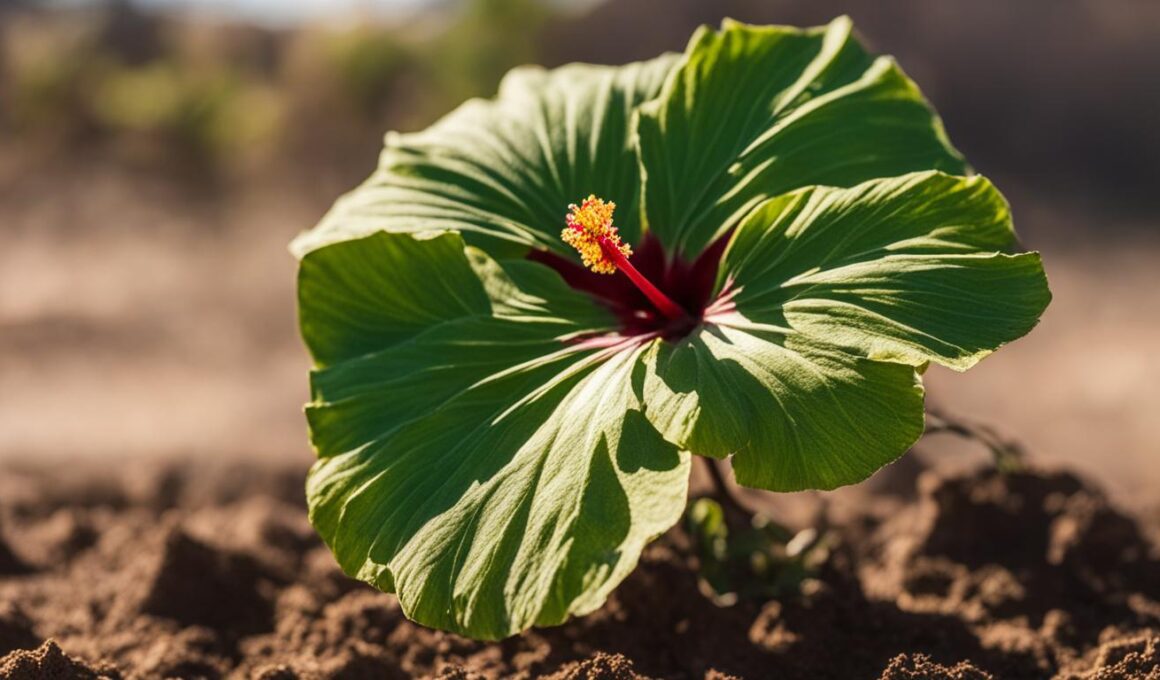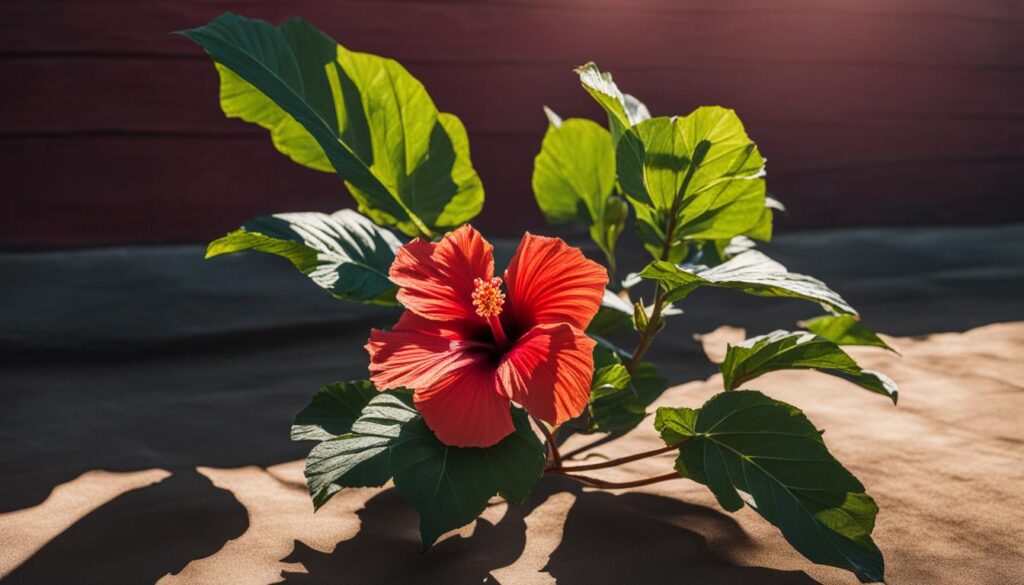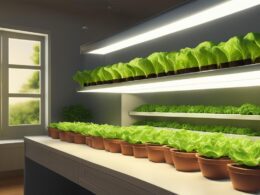Providing the right hibiscus care is crucial for a healthy and vibrant plant, but what should you do when your hibiscus stops producing flowers? A non-flowering hibiscus can be disappointing and frustrating, leaving you wondering where you went wrong. In this article, we’ll explore some common hibiscus bloom problems and offer guidance on how to address them so you can enjoy a blooming hibiscus once again.
Various factors can cause hibiscus not to flower, such as inadequate sunlight, inconsistent watering, and excessive fertilization. Learning about these issues and adopting appropriate hibiscus growing tips will help to ensure that your hibiscus plant thrives and produces an abundance of stunning blooms throughout the season.
Key Takeaways
- Non-flowering hibiscus plants may be due to inadequate sunlight, improper watering, or excessive fertilization.
- Ensuring that your hibiscus plant receives enough direct sunlight is crucial for flower production.
- Adopting consistent watering practices and maintaining proper soil moisture can help prevent plant stress and promote blooming.
- Using a balanced fertilizer and avoiding excessive nitrogen can encourage hibiscus flowers.
- Regular pruning and providing an optimal microclimate for your hibiscus plant can ensure its overall health and ability to produce flowers.
Understanding Hibiscus Bloom Cycles and Environmental Needs
The hibiscus bloom cycle is characterized by regular rounds of flowers throughout the blooming season, which can vary depending on the specific species of hibiscus. Regardless of the type, optimal environmental conditions play a significant role in achieving a beautiful display of flowers. Let’s dive deeper into the ideal conditions for hibiscus plants, such as sunlight requirements, watering methods, and appropriate fertilization.
Hibiscus Sunlight Requirements
One of the most important aspects of hibiscus environmental needs is sunlight exposure. It is essential to provide your hibiscus plant with at least 6 hours of direct sunlight daily to promote blooming. However, in regions where summer heat is more intense, partial sun or filtered light might be enough to prevent stress while still encouraging flower production. Keep an eye on your plant’s sun exposure throughout the season and adjust its location accordingly.
Watering Your Hibiscus Plant
Proper watering plays a crucial role in maintaining a flourishing hibiscus bloom cycle. Consistent and appropriate watering helps maintain soil moisture without causing over-saturation. It is important to note that your plant’s water needs may change based on factors such as temperature, humidity, and the size of the container it’s planted in. Monitor the soil moisture and adjust your watering habits accordingly to create the ideal conditions for hibiscus plants.
Fertilization and Soil Balance
Providing your hibiscus plant with the right nutrients is another critical aspect of its environmental needs. Soil testing can help guide your choice of fertilizer, ensuring it supplies the proper nutrient balance to support flower production. A balanced fertilizer with a ratio of 12-4-8 (nitrogen, phosphorus, and potassium) is generally recommended for hibiscus plants. Avoid excessive nitrogen, as it can lead to lush foliage at the expense of blooming.
| Aspect | Optimal Condition |
|---|---|
| Sunlight | At least 6 hours of direct sunlight daily |
| Watering | Consistent moisture without over-saturation |
| Fertilization | Balanced 12-4-8 fertilizer |
By understanding the hibiscus bloom cycle and environmental requirements, you can provide the proper care your plant needs to thrive. Ensuring adequate sunlight, consistent watering, and balanced fertilization will pave the way for a healthy hibiscus plant adorned with vibrant flowers throughout the blooming season.
Common Culprits: Identifying Reasons for Lack of Blooms
Several factors can lead to hibiscus plants experiencing inhibited flowering. The primary culprits are insufficient sunlight exposure, improper watering habits, and imbalanced fertilization. In this section, we will discuss each issue and highlight ways to identify and address them.
Insufficient Sunlight Exposure
Hibiscus sunlight exposure plays a pivotal role in successful blooming. These plants require at least a few hours of direct sunlight per day for healthy growth and flower production. Environmental changes, such as increased shade from the growth of surrounding trees or new structures, can dramatically impact your hibiscus’ ability to produce flowers. To address this issue, monitor sunlight levels throughout the day, and if necessary, reposition your plant to a sunnier location. Keep in mind that changes in sunlight exposure must be made gradually to avoid subjecting your hibiscus plant to additional stress.
Watering Issues and Plant Stress
Watering hibiscus plants directly affects their ability to produce blooms. Both underwatering and overwatering can cause plant stress, leading to dropped buds or leaves and a lack of flowers. Hibiscus plants require regular and sufficiently deep watering to prevent drought stress. However, they should not be allowed to sit in water or have consistently soggy soil.
To avoid hibiscus watering issues, follow these guidelines:
- Maintain even soil moisture by checking the soil regularly.
- Water deeply to promote proper root growth. This allows the plant to access water and nutrients more efficiently.
- Adapt your watering schedule based on factors like summer heat, humidity, and the plant’s individual needs.
By employing consistent and appropriate watering habits, you can maintain optimal moisture levels and reduce plant stress, encouraging your hibiscus to bloom.
Fertilization: Finding the Right Balance
While proper fertilization can boost hibiscus health and vitality, an excess of nitrogen may lead to the plant focusing on producing lush greenery at the expense of flowers. The recommended fertilizer ratio for hibiscus is 12-4-8, which supports both nitrogen and potassium needs. However, using an imbalanced fertilizer can lead to a lack of blooms.
To ensure proper hibiscus flower fertilization, consider conducting a soil test to determine the nitrogen levels in your garden. This will enable you to tailor your fertilizer approach, addressing any deficiencies or imbalances to encourage flowering. Pay particular attention to the nitrogen balance, and adjust your fertilizer choices accordingly to promote optimal growth and flower production.
By identifying and addressing these common culprits, you can take essential steps to promote successful hibiscus flowering, and enjoy the vibrant, colorful blooms that these stunning plants are known for.
Potential Solutions: How to Encourage Hibiscus Flowers
When attempting to encourage hibiscus blooms, it is vital to meet the plant’s specific needs. The following hibiscus bloom solutions will help you create the ideal environment and boost hibiscus flowering:
- Ensure Adequate Sunlight: Hibiscus plants require direct sunlight, so make sure they receive at least 6 hours of sun per day.
- Maintain Consistent Watering: Implement a regular watering schedule based on your plant’s specific needs and climatic conditions. Always check the soil moisture before watering.
- Optimize Humidity: Hibiscus plants thrive in high humidity environments, so consider using a humidifier or misting the plant’s leaves to maintain humidity levels.
- Use Appropriate Fertilizers: Apply a balanced fertilizer, such as diluted fish emulsion with seaweed, bi-weekly to provide essential nutrients for blooming.
- Repot Hibiscus in Properly Sized Containers: Re-potting your hibiscus can help promote blooming by balancing root and foliage growth.
To better understand the needs of your hibiscus, consider conducting a soil test to analyze nutrient levels and inform your fertilization strategy. The table below indicates the preferred nutrient values for hibiscus plants.
| Nutrient | Preferred Value |
|---|---|
| Nitrogen (N) | 12% |
| Phosphorus (P) | 4% |
| Potassium (K) | 8% |
| pH Level | 6.0 – 6.5 |
Monitoring and adjusting your hibiscus care based on its specific needs are essential steps in encouraging its blooms. By providing the right environmental conditions and timely care, you can boost hibiscus flowering and enjoy the vibrant colors of these stunning plants.
Pruning and Plant Care: Tips for Optimal Growth
Pruning plays a crucial role in achieving healthy and flourishing hibiscus plants. When executed correctly, pruning not only revitalizes the overall growth patterns but also positively impacts the flower production of hibiscus plants. Let’s explore how you can enhance your hibiscus plant care through effective pruning techniques.
The Impact of Pruning on Flowering
Removing dead growth or sparsely leaved branches from hibiscus plants, especially older or overgrown ones, can rejuvenate their growth patterns and lead to improved flower optimization. However, it’s important to approach significant pruning with caution. In most cases, it’s recommended not to remove more than one-third of the plant during any trimming session, unless you specifically aim to rejuvenate a non-blooming hibiscus.
Regularly deadheading spent flowers not only helps in maintaining a tidier plant appearance but also aids in preventing potential disease and pest issues. By adopting these effective hibiscus pruning practices, you can ensure your plant produces an eye-catching display of vivid and enchanting blooms throughout the season.
- Prune during late winter or early spring when the plant is dormant.
- Ensure pruning shears are sharp and sanitized to prevent the spread of disease.
- Avoid excessive pruning to prevent stress on the plant.
- Prune in a way that preserves the plant’s natural shape and promotes balanced growth.
- Monitor plant health closely post-pruning to identify any emerging issues or concerns.
Beyond pruning, there are several other aspects of hibiscus plant care that contribute to its optimal growth and flowering. Incorporate the following measures to create a healthy environment for your hibiscus plants:
| Plant Care Aspect | Recommended Actions |
|---|---|
| Watering | Water hibiscus regularly, maintaining even soil moisture without causing soggy conditions. |
| Fertilizing | Use balanced fertilizers, such as a 12-4-8 ratio, and conduct soil tests to tailor nutrient inputs for hibiscus needs. |
| Soil | Opt for well-draining soil rich in organic matter, with a slightly acidic to neutral pH (6.0 to 7.0). |
| Pest Control | Monitor plants for pests, such as aphids or spider mites, and implement controls as needed to prevent damage. |
By diligently practicing proper pruning techniques and comprehensive hibiscus plant care strategies, you’ll bolster the growth and flowering potential of your plants, showcasing their captivating beauty in your garden landscape.
Advanced Tactics: Soil Testing and Microclimate Management
While ensuring adequate sunlight and proper watering practices are vital for hibiscus flower production, soil testing for hibiscus and managing the plant’s microclimate can further optimize its environment, leading to more abundant blooms.
A soil test can reveal essential information about soil composition, nutrient levels, and pH, enabling you to make any necessary adjustments to promote healthy hibiscus growth and flowering. Soil tests can help determine what kind of fertilizer is best suited to your hibiscus, ensuring your plant receives an ideal balance of nutrients for maximum bloom potential.
A hibiscus microclimate, which considers temperature, humidity, and pest control, is essential for protecting sensitive blooms and maintaining overall plant health. Creating a stable microclimate requires managing the following elements:
- Temperature
- Humidity
- Pest control
Temperature and Humidity
Extreme temperature fluctuations and inappropriate humidity levels can stress hibiscus plants, leading to bud drop or reduced flowering. To maintain a thriving hibiscus microclimate, consider the following tips:
- Use shading techniques to protect your hibiscus from the hot midday sun in warmer climates.
- Increase humidity by placing a tray of water near the plant or misting the leaves regularly.
- Monitor temperatures closely and move potted hibiscus plants indoors during frost or extreme heat.
Pest Management
Effective hibiscus environment management also involves keeping pests in check. Common pests, such as Japanese beetles or spider mites, can damage hibiscus flowers and harm the plant’s overall health. Employ organic pest control solutions to address infestations, including:
- Hand-picking beetles from the plant.
- Applying insecticidal soap for mite-infested plants.
- Utilizing predatory insects, such as ladybugs, to help control small pests.
Taking a comprehensive approach to managing the hibiscus environment, including soil testing for hibiscus and creating a conducive microclimate, can create the ideal conditions necessary for your hibiscus plant to thrive and produce stunning, vibrant flower displays.
Is Lack of Proper Care or Watering the Reason Behind Your Hibiscus Not Flowering?
If your hibiscus plant is not flowering, it could be due to lack of proper care or watering. Check for aloevera plant drooping symptoms like wilting leaves, dry soil, or yellowing foliage. Ensure your hibiscus gets enough sunlight, well-draining soil, and regular watering to encourage blooming.
Conclusion
When it comes to successful hibiscus flowering, understanding and meeting the plant’s needs is essential. Factors such as sunlight exposure, watering, and fertilization play pivotal roles in ensuring hibiscus health. To optimize these hibiscus blooming factors, make it a priority to address any issues promptly and adjust plant care practices accordingly.
Regular pruning and care are necessary for maintaining vibrant, healthy hibiscus plants. Advanced soil and microclimate management techniques can further enhance the plant’s health and bloom production. By creating the ideal conditions for hibiscus plants, they will reward you with a stunning display of lush, vibrant flowers.
In conclusion, a successfully flowering hibiscus lies in providing the requisite care and attention it needs. Stay observant to the plant’s needs, respond to specific environmental factors, and commit to implementing effective management practices, your hibiscus plants will surely thrive and showcase the beautiful blooms you desire.












